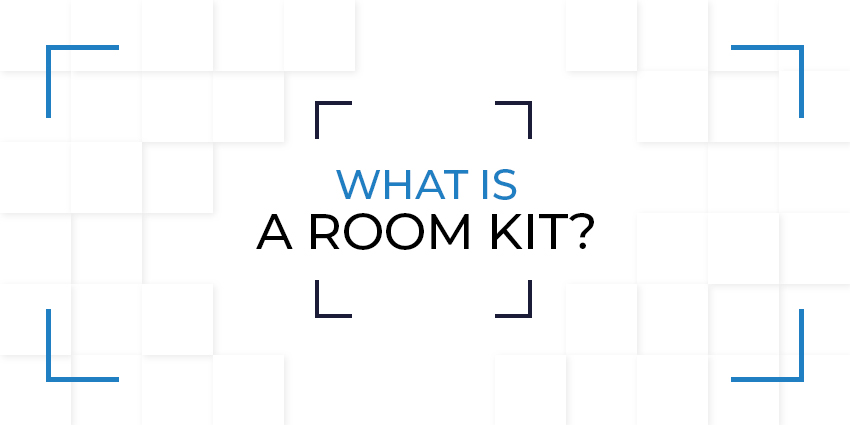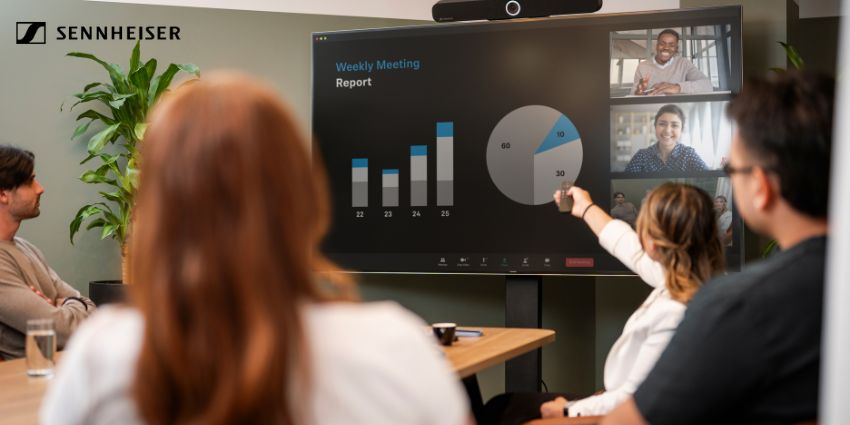There’s no question that the modern meeting has changed from what it was just a few years ago. Whether in-person or remote, meetings now consist of far more than a group of people gathering in a room to jot ideas down on a whiteboard, and the meeting room has changed with them.
Today’s meeting rooms now feature cameras, conference phones, speakers, and more, in order to create an optimal meeting experience for all attendees and support remote and hybrid workers. This has contributed in large part to the growth of the video conferencing devices market, which Frost & Sullivan estimates will reach over $7.7 billion by 2025.
Fortunately, the technology used in meeting rooms has also grown both in ease of use and overall features. While implementing meeting room hardware in the past was an expensive and time-consuming process, requiring businesses to invest in equipment and pay specialists for installation and maintenance, the modern meeting room can be set up far more easily, particularly by using room kits.
So, what are room kits, and what do they bring to meeting rooms? Let’s explore.
The Modern Room Kit
A room kit is, as the name suggests, a package (or kit) specifically designed for meeting and video conference rooms. It includes everything needed for an immersive meeting, including cameras, microphones, and displays that help make remote and hybrid participants as present in the meeting as in-person attendees.
Think of it as a kit similar to a UC bundle, only designed specifically for meeting rooms.
The specifics for a room kit will vary based on the room’s needs and the provider, but typically, kits will include:
- A smart speaker
- Noise-canceling microphones
- Ceiling arrays
- Video displays
- Virtual whiteboards
- Virtual or AI assistants
Of course, these are designed to work with the software and solutions businesses use for their daily communications, and are often sold by the same solution providers and vendors. As such, businesses can set up meeting rooms and launch meetings without needing to worry about disparate systems and compatibility issues, creating a more seamless meeting experience.
The Benefits of Room Kits
Room kits are often designed as plug-and-play solutions, where businesses can set them up in any room with available space. Many only need to connect a single cable to get started, so they’re easy to install.
Room kits can help smaller businesses access the same meeting room experience as larger enterprises, without needing to invest significant time or money in purchasing and installing multiple different solutions and equipment. Room kits tend to be agile and versatile, making them popular choices among teams and businesses of all sizes.
Of course, the main benefit of room kits comes with the consolidation of everything needed for virtual meetings. In this age of hybrid work, meetings are more likely to have at least a few remote attendees than not, so meeting rooms need to be able to accommodate them. Room kits enable this by providing tools such as monitors, cameras, and microphones to hold quality video meetings alongside in-person meetings, while often including tools and functionality to enhance the meeting experience.
For employees who work remotely, teams working from different locations, and anyone on the go, this is invaluable and allows them to keep meeting no matter where they’re located.
Huddle Rooms
Huddle rooms are a more recent trend, but one that has significantly contributed to the rise of the room kit. A huddle room is a smaller meeting room, but one that’s still equipped with audio and video capabilities for quick team meetings.
One major benefit to huddle rooms is that they’re typically available without needing to book them, unlike larger conference rooms. Anyone in need of a quick meeting can grab the nearest available huddle room and launch a meeting while leaving the larger rooms available for bigger groups and more pressing matters.
Huddle rooms also make use of extra space, utilizing those small rooms that often sit unoccupied around office buildings. They facilitate collaboration for all teams and team members, rather than letting the larger teams monopolize the rooms, and enable quick meetings with remote employees.
As huddle rooms tend to be on the smaller side, their technical needs are also simpler than the larger meeting rooms tend to have. A single display screen, camera, and microphone typically work well for huddle rooms, and fortunately, there are room kits designed for smaller huddle room meetings, while offering the same functionality as larger rooms.
What’s Next for Room Kits?
Room kits continue to evolve as the need for agile, readily available meeting rooms grows and the technology for meetings develops. While today’s room kits include cameras, speakers, microphones, and codecs integrated into a single device, they’re also becoming more scalable and customizable.
As room kits develop, new features are constantly being added, like noise suppression to automatically block out distracting background noise. Other developing features include virtual whiteboards and 4K content sharing, enabling more efficient meetings with real-time teamwork. Integrations are also steadily growing, as businesses want their room kits to work seamlessly with the tools and software they already use, which also means that open frameworks and flexible connections are of growing importance.
And of course, as artificial intelligence continues to grow, companies are finding ways to use it in their room kits. This often takes the form of virtual assistants for calls, as well as common AI meeting features such as automatic transcriptions, post-meeting summaries, noise suppression, and speaker tracking.
Room kits remain an agile and convenient way to launch and join meetings at a moment’s notice while bringing in-person and remote attendees into a single room. Businesses of all sizes can use them to access immersive and scalable meetings with minimal setup and legwork, empowering a video-first culture and supporting hybrid work environments.







